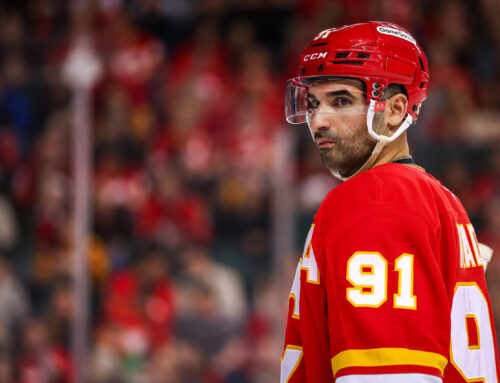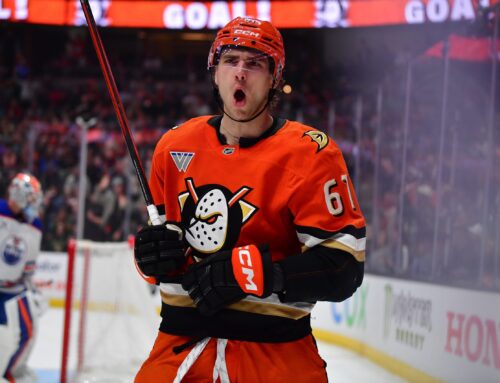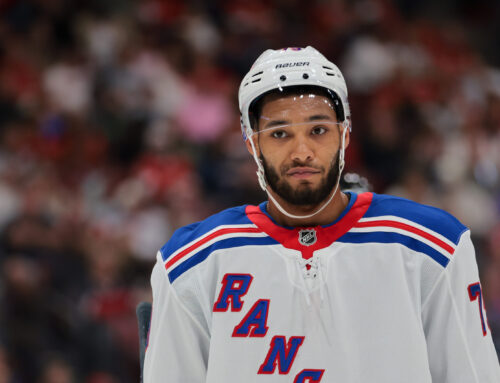Even though scoring was up to almost 30-year highs, it wasn’t all peaches and cream for fantasy general managers.
Despite the increase in scoring, there were still plenty of forwards who struggled to put up points.
Last week, we focused on the top 10 disappointing netminders. It makes sense that goalies would struggle when scoring is up, but some of the players on this list should have been much better than they were.
Below are the top 10 forwards who were disappointments this season. Note that players who performed well while in the lineup but missed a bunch of games due to injury are not included. So, no Patrik Laine, Mark Stone, Cole Caufield, Nikolaj Ehlers, etc.
10. Evander Kane
Even though injuries can’t be used solely for this list, they can be a contributing factor, and for Kane, that injury was the start of a disappointing season. Kane had 13 points in 14 games before he was taken out for months after a skate lacerated his wrist. When he got back into the lineup, he wasn’t the same, finishing with 15 points in his last 27 games. That’s adequate, but consider what we were hoping for going into the year: Last season, he had 22 goals and 39 points in 43 games with the Oilers, then followed that up with 13 goals (league leading) and 17 points in 15 postseason games. Many were hopeful that he could have potentially reached 40 goals and 70 points for the first time in his career, but even without the injury, he was only on pace for 32 goals and 56 points.
9. Ryan Hartman
A year ago, Hartman was a surprising 65-point player, which had crushed his previous high of 31 points. Much of that was thanks in large part to a steady diet of playing on the top line alongside Kirill Kaprizov. Last season, according to Natural Stat Trick, Kaprizov was on the ice for 72.4 per cent of Hartman’s five-on-five minutes. This year, that number dropped to 48.2 per cent. That’s a big reason why Hartman only finished with a 51-point pace (37 points in 59 games). Sure, missing 23 games with an injury after a fight (plus a one-game suspension and a healthy scratch) will hurt production, but his ice time was also down almost two minutes per night when healthy, and his power-play time was almost cut in half. His shots-per-game mark was also down.
8. Alex Newhook
Not every player who disappointed us is elite or was expected to be a point-per-game player. After the exodus of Avalanche players last summer, there were hopes Newhook would get that second-line centre spot and become a 50-point producer. Not only did his numbers not become fantasy relevant, but they actually declined from a 38-point pace a year ago to a 30-point pace this year. He was also worse in plus-minus, shots per game and blocked shots. His power-play production also dropped from six a year ago to a measly two this season. He started the season pointless in eight games, which wasn’t even his longest pointless streak of the year (he went pointless in 12 near the end of the campaign). It wasn’t quite bad enough to be considered a sophomore slump, but fantasy GMs will be extremely hesitant on drafting him next year.
The trade to Boston kind of saved his season a little bit. All the resting of David Krejci and Patrice Bergeron down the stretch allowed Bertuzzi to get a top-six spot for the last few weeks, but make no mistake, this was a disastrous season for the former Red Wing. On the whole, he finished with 30 points in 50 games for a 49-point pace. Aside from 2020-21 when he was limited to nine games due to injury, those 30 points are his lowest total since his 24-point rookie campaign of 17-18. With Detroit this year, he had 14 points in 29 games. He had 16 points in 21 games with Boston, including 10 in his last eight, which helps keep him from being higher on this list.
After last season’s 78-point bounce-back season, there was speculation that his poor 2020-21 season when he had 29 points in 41 games was an anomaly. After all, in four of the five previous seasons, he had an 82-game pace ranging from 68 to 86 points. However, this year his production dropped again as he finished with 55 points in 81 games. Not horrible, but not great either, especially when you consider he spent a good chunk of the season alongside Alexander Ovechkin. But it’s his poor second half that gets him on this list. He started with 36 points in his first 40 games, but followed that up with 19 points in his last 41. It’s a lot easier to forgive a slow start than a poor finish.
5. Seth Jarvis
One of the most popular “breakthrough sleeper” candidate picks last preseason, Jarvis was given a top-six role, saw his ice time increase by 2:20 per night, was given more time on the power play and increased his shot rate to 2.3 shots per contest. And all of that somehow led to a decrease in points production. He went from 40 points in 68 games (a 48-point pace) as a rookie to 39 in 82 as a sophomore. Almost all of the Hurricanes’ forwards outside of Martin Necas had disappointing seasons, so maybe Jarvis was just following the trend of the rest of the squad.
A year ago, Kreider had the most unlikely 50-goal season since Jonathan Cheechoo. While no one was expecting another 50-goal year, there was hope he could continue to put up points since he was playing a top-six role alongside Mika Zibanejad and on the top power-play unit. Last year, he had 52 goals. This season, he had 54 points. Maybe we shouldn’t have been surprised and chalked this up similar to Nazem Kadri‘s season, where 2021-22 was an aberration. In the five seasons before last year’s 77-point campaign, Kreider’s 82-game pace ranged from 49 to 59. Why were we so confident that last year wasn’t an anomaly and that he would continue to get 70? Maybe he is exactly what his numbers say he is: A sub-60-point player.
3. Patrick Kane
There were many fantasy general managers who drafted Kane in the hopes he would be decent enough in the first half of the season and see an immediate uptick in production once he was dealt. After all, he’s been a point-per-game player in 11 of the past 13 seasons and had at least a 96-point pace in four straight leading into this one. He struggled for most of the year with Chicago, but 10 points in his last four games as a Blackhawk pushed his numbers up. Overall, he put up a 0.83-point pace this season in Chicago before he was dealt to the Rangers, where his numbers plummeted. He finished with 0.63 points per game in New York and had five points in his last 11 games during the fantasy postseason. Overall, he had 57 points in 73 games. When you throw in his worst plus-minus of his career, his shots-per-game rate dropping to his lowest in eight years, and the fact he doesn’t hit or block shots, it was a complete disappointment.
2. Bryan Rust
Rust started the season with five points in three games, but then he had underwhelming production with five points in his next 21 games. He was taken off the top power-play unit, and then immediately responded with four points in his next game and 23 in his next 27 games. However, that hot streak wasn’t enough to save his disastrous season. One interesting (but coincidental) note about Rust is that his three most productive seasons have come when he’s played 60 or fewer games. In the year when Covid shut everything down, he had 56 points in 55 games. In the covid-shortened season where teams only played other teams in their division, he had 42 points in 56 games. Last year, injuries limited him to 60 games, but he still had 58 points. This season, he finished with 46 points in 81 games
There was never any doubt who was going to be number one on this list. I’m sure there are plenty of fantasy general managers who think he should occupy the top five spots on his own. Huberdeau’s 55 points were fewer than half of the 115 points he had the year before. That’s not great for a player many drafted in the first round. Essentially, his production dropped in every single fantasy-relevant category. He went from 30 goals to 15. His plus-minus cratered from 35 to two. His shots per game rate went from 2.8 to 1.6. He went from 54 PIM to 36 and 99 hits to 65. His power-play production dropped from 38 to 15. Even his normal paltry stats in blocked shots and faceoff wins decreased. A lot of this can be chalked up to coaching. Huberdeau’s ice time dropped an average of around 2:30 per game, and he spent almost as much time five-on-five with Milan Lucic and Blake Coleman as he did with Elias Lindholm and Tyler Toffoli. There was also the disastrous decision to move Huberdeau to the right wing position for a good chunk of the year after he’s played left wing his entire life. However, you would still expect an elite player to produce no matter where they are on the ice or who they are playing with.
One Comment
Leave A Comment
You must be logged in to post a comment.





 PHI
PHI TOR
TOR ANA
ANA NYI
NYI BUF
BUF CGY
CGY VAN
VAN CAR
CAR STL
STL MTL
MTL BOS
BOS

Usually, I like my players being on your top 10 lists but not today, thankfully I only have 2 on this list, Bertuzzi & Kreider, although I own Bertuzzi in several pools. I think Lundholm in Cal makes the top 10 as well, his play was also devasting for me.